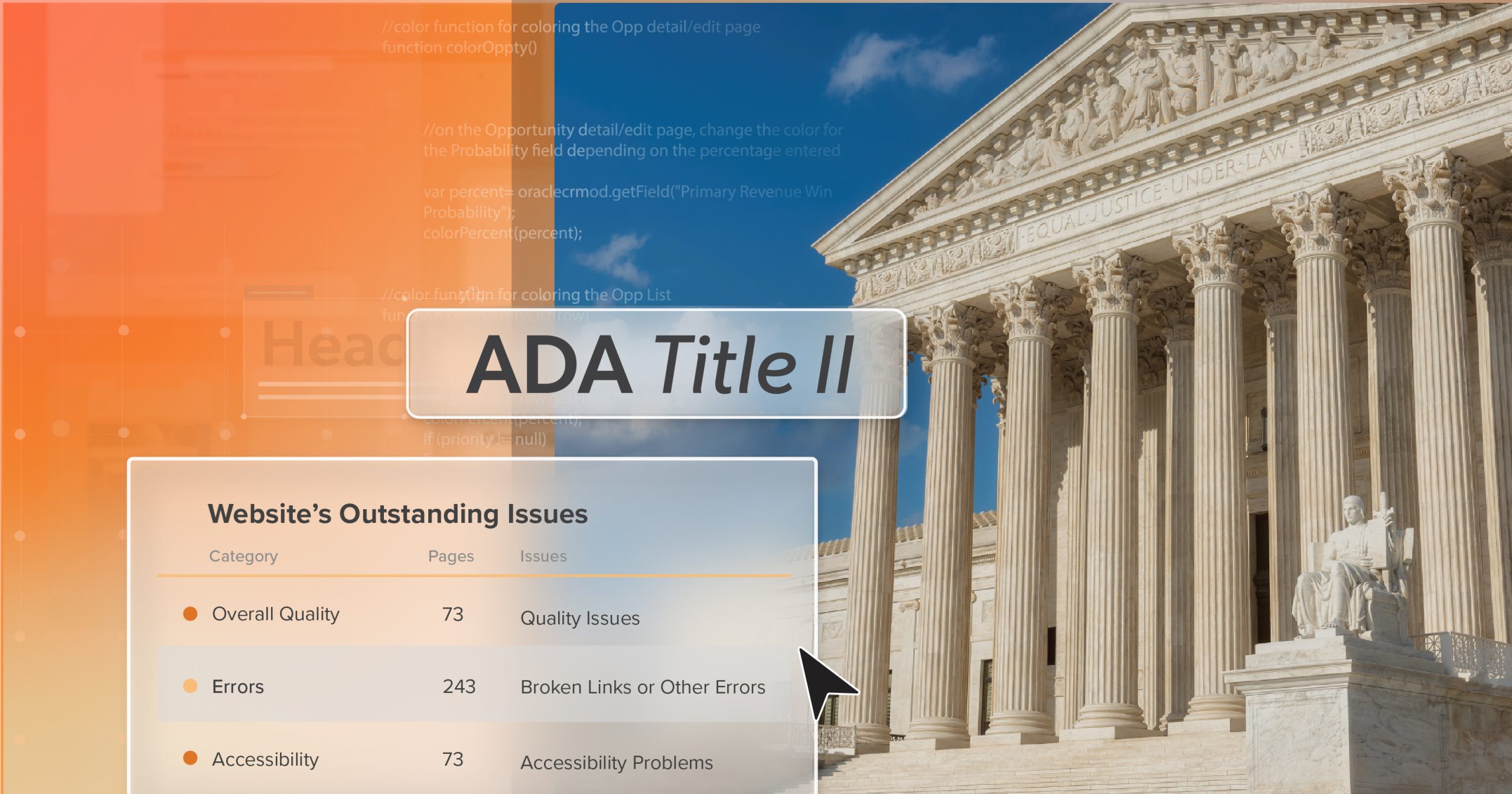April 2026 is fast approaching, and it marks a pivotal shift in how government and educational institutions must deliver their digital services. In April 2024, the U.S. Department of Justice (DOJ) finalized new rules under Title II of the Americans with Disabilities Act, requiring that public entities make their websites and mobile apps conform to WCAG 2.1 Level AA standards.
This update creates a clear and enforceable standard for digital accessibility—and a fixed timeline. Large entities serving 50,000 or more people must achieve ADA Title II compliance by April 24, 2026. Smaller entities, including towns, special districts, and small school systems, must follow by April 26, 2027.
This isn’t just about meeting regulations. It’s about ensuring that everyone—including people with disabilities—can use essential public services online, from paying utility bills to registering for classes or receiving emergency alerts.
Understanding the Scope of ADA Title II Compliance
The rule applies to nearly all state and local government organizations, including:
- Cities, counties, and municipalities
- Public universities and school districts
- State agencies and special districts such as transit, water, or fire authorities
It also indirectly includes any private vendors that design, build, or maintain digital platforms for these organizations. Even if a vendor creates or operates your digital platform, responsibility for accessibility—and legal liability—remains with the public entity.
This broad scope means development, design, content, and procurement teams must work in sync. Accessibility is no longer a “nice to have” feature or a patchwork afterthought. It must be an intentional part of the lifecycle of digital services.
The New Baseline: WCAG 2.1 Level AA
For years, WCAG has served as the de facto best practice for digital accessibility. Now, it’s the legal benchmark. ADA Title II compliance requires conformance to WCAG 2.1 Level AA across websites and mobile apps.
The WCAG framework is built on four key principles:
- Perceivable: Information must be presented in ways users can recognize and process—through sight, sound, or touch.
- Operable: All functionality must be usable via a range of input methods, such as keyboards or voice controls.
- Understandable: Content and interfaces should be clear, consistent, and predictable.
- Robust: Code must follow accepted standards to work reliably with assistive technologies.
For developers, this translates into semantic HTML, accessible form structures, proper use of ARIA where needed, support for keyboard navigation, sufficient color contrast, captions and transcripts for media, and responsive design that works across devices.
Key Deadlines and Limited Exceptions
The DOJ’s final rule establishes staggered deadlines to account for the varying resources of different entities:
- April 24, 2026: Large public entities (50,000+ population) and major school districts must comply.
- April 26, 2027: Smaller municipalities, rural counties, special districts, and small school systems must comply.
Some content is exempt: archived web materials, third-party content not posted by the entity, individualized password-protected content (like a specific utility bill), preexisting social media posts, and older electronic documents not currently in active use. These exceptions are narrow and shouldn’t be treated as a loophole—most public-facing content still must be accessible.
Why This Deadline Signals a Shift
This rule does more than set a date. It establishes a uniform digital standard across public services—and that’s transformative.
By naming WCAG 2.1 Level AA as the clear benchmark, it ends ambiguity. Public trust is strengthened as people with disabilities gain guaranteed equal access. Legal risk drops as the gray areas that once fueled costly lawsuits and settlements disappear. At the same time, accessibility is pushed to the forefront of digital strategy instead of being treated as an optional side task.
Accessibility now sits at the center of how public organizations plan, design, build, and maintain their digital platforms.
A Phased Roadmap Toward ADA Title II Compliance
Because comprehensive remediation can take months—or longer for complex ecosystems—waiting until late 2025 risks running out of time. A phased approach helps build steady momentum.
Phase 1: Assess and Organize (Now through Mid-2025)
Begin by identifying who will lead accessibility efforts. Take inventory of every public-facing digital property, including web apps, mobile apps, forms, and documents. Then schedule a thorough accessibility audit, prioritizing the most used or most critical services like billing systems, course registration, or emergency alerts.
Phase 2: Plan and Prioritize (Mid-2025 through End-2025)
Use your audit findings to map out a remediation plan tied to your budgeting cycles. Secure executive buy-in early. Accessibility should be positioned as a matter of governance and public trust, not just a technical task assigned to IT.
Phase 3: Remediate and Test (Early 2026)
Implement code-level fixes, update design patterns, and correct content barriers. Use both automated and manual testing, and incorporate usability testing with people who use assistive technologies. Their insights will surface barriers that automated tools often miss.
Phase 4: Embed in Procurement and Governance (Ongoing)
Update procurement language to require WCAG 2.1 AA conformance for all vendors. Include accessibility testing, documentation, and verification milestones in contracts. Establish internal policies for accessible design and development practices going forward.
Phase 5 : Maintain Accessibility Long-Term (Post-Deadline)
Schedule recurring audits, provide continuous staff training, and build accessibility checks into your development and content workflows. Establish a feedback channel for users to report barriers and ensure those reports trigger timely remediation.
Common Pitfalls That Derail Progress
Even well-intentioned teams can lose ground as deadlines approach. These are common issues to avoid:
- Stopping at the audit: An audit reveals issues; it doesn’t fix them. Plan for remediation, re-testing, and validation.
- Over-relying on automation: Automated tools catch only a fraction of WCAG criteria. Manual reviews are essential.
- Leaving vendors unchecked: Accessibility obligations don’t end at the contract signature. Require proof of ADA Title II compliance.
- Relying on overlays or widgets: These often fail to solve root issues and can introduce new barriers.
Beyond April 2026: Sustaining ADA Title II Compliance
ADA Title II compliance is not a project that ends on launch day—it’s an ongoing obligation. Accessibility should become a standing component of your governance model.
Include accessibility reviews in your CI/CD pipelines to catch regressions early. Track and adopt updates to WCAG—2.2 has already arrived, and 3.0 is in development. Maintain documentation of policies, testing protocols, and training records to demonstrate due diligence if audited or challenged.
And don’t overlook communication. Sharing progress with your community shows accountability and reinforces public trust. Transparency builds confidence, both internally and externally.
Getting Started Now
You don’t need to overhaul everything at once. Early, visible progress helps build support and momentum. Start by:
- Conducting a comprehensive audit to establish a baseline
- Fixing accessibility barriers on high-traffic pages and applications
- Training staff who create or maintain digital content
- Updating vendor contracts and procurement templates with WCAG 2.1 AA language
- Implementing ongoing monitoring to prevent regressions
Even these first steps will make your platforms more usable while laying the foundation for full compliance.
Turning Deadlines Into Opportunity
The 2026 and 2027 deadlines for ADA Title II compliance are closer than they seem, but they’re absolutely achievable. With a deliberate plan, you can meet the requirements without last-minute scrambles—and create more inclusive digital services in the process.
This is more than a legal mandate. It’s a chance to improve the experience for everyone who relies on your digital platforms. Starting now allows you to spread out the workload, secure the resources you need, and avoid costly last-minute vendor rushes.
If you need support, 216digital partners with public entities to conduct audits, provide remediation, train teams, and implement ongoing monitoring.
Now is the moment to prepare. Schedule an ADA briefing and set your roadmap in motion—on time, on mission, and built to last.


